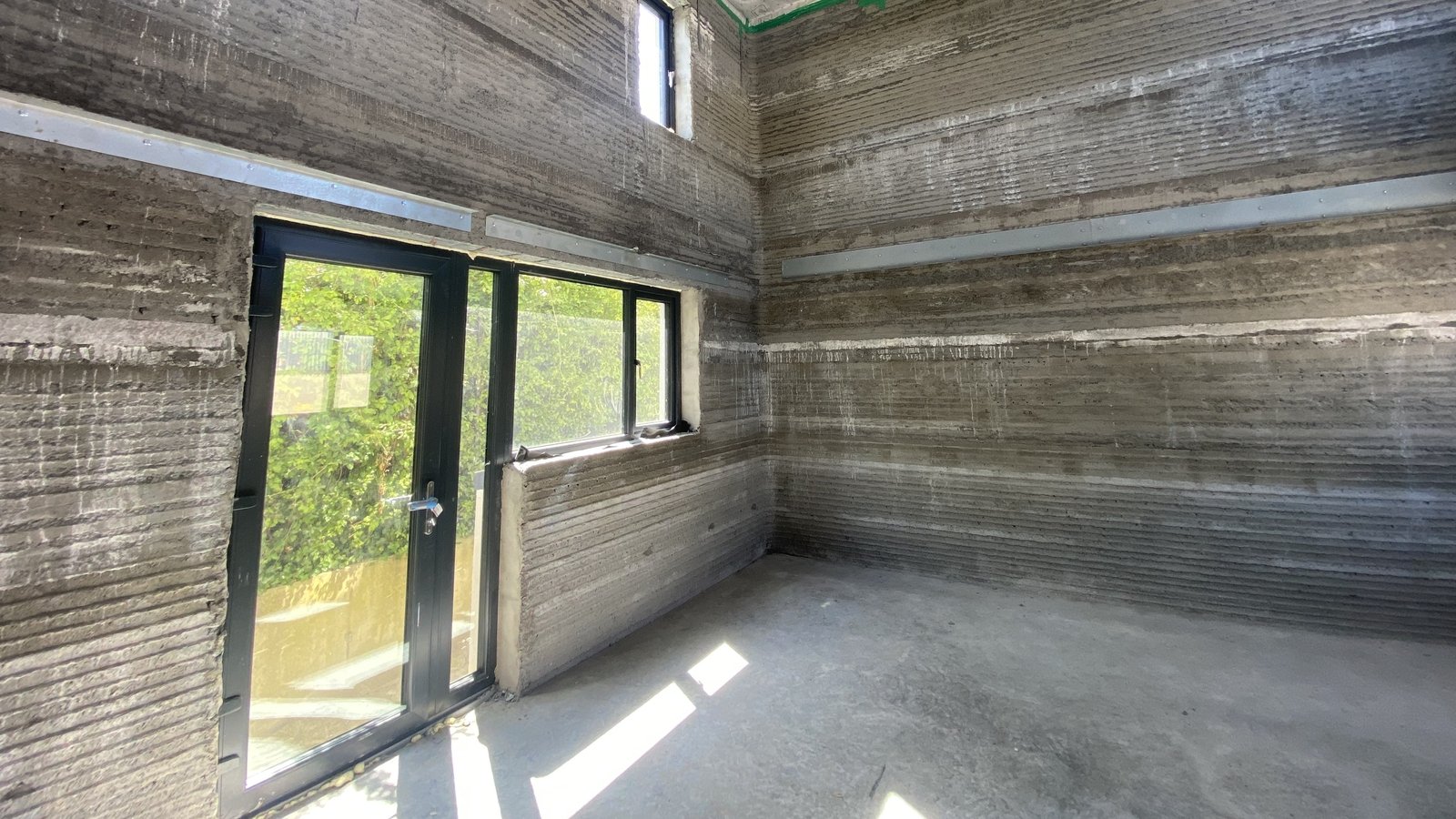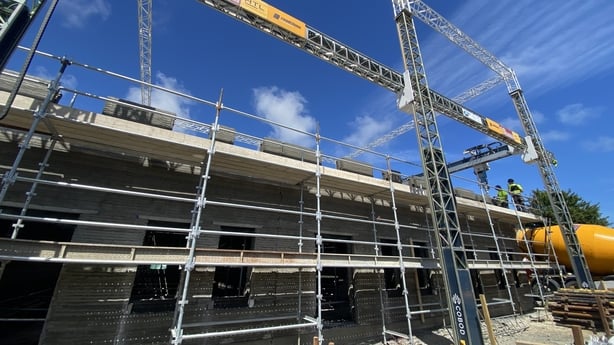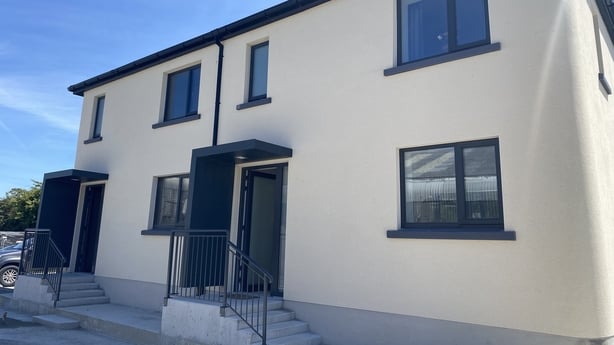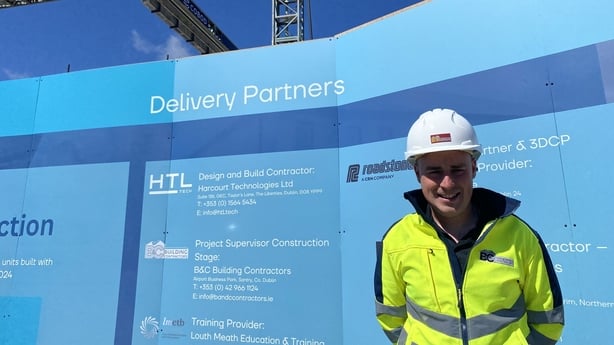World
Ireland’s first 3D printed homes being built in Dundalk

Layer by layer, a 3D concrete printing machine has been building new homes in Dundalk from the ground up over the last two weeks.
The three social housing units located at Grange Close in Dundalk, will be the first 3D printed homes in Ireland.
The technology is said to speed up the construction process and use less labour.
It uses 3D concrete printer erected on a gantry, which has been programmed to pipe concrete out following a digital plan.
It builds cavity walls from scratch, without using concrete blocks.
“Its just the same as a concrete block wall. Instead of placing it manually by hand, the machine lays 50mm layers”, said Justin Kinsella MD of Harcourt Technologies (HTL).
“As architects and engineers, we design the building in a digital model. That model is transferred to the printer and it tells the printer where to extrude material. The machine really just goes around and processes layer after layer of concrete and it works very quickly,” he said.
HTL is the construction tech company who has brought this technology to Ireland.
It said that the houses in Dundalk will be built three times faster than they would using traditional concrete blocks and it expects to hand the keys over to Louth County Council this October.
Mr Kinsella also said that this method uses a third of the labour normally required and also reduces the construction schedule by between 25-30%.
“It reduces labour by roughly a third, increases the comparative speed if one was doing it manually, by roughly three times and the overall construction programme helps housing be delivered 25-30% faster than it’s current iteration. We see that getting far shorter as time goes on and as we optimise it further,” said Mr Kinsella.

At the moment, it takes about 18 minutes for the 3D printer to lay a 50ml layer of concrete around the three-unit block on the site in Dundalk.
Ii is hoped this time will be reduced to 12 minutes from next week.
In terms of cost, it is still comparable to concrete block construction.
“The real cost advantage is the speed at which the housing is delivered. Costs can be reduced quite significantly if you’re on site for 25-30% less of the time. That’s the technology margin that we’re looking at at the moment”, Mr Kinsella said.
Before starting the pilot project on site in Dundalk, they built two test houses at their R&D facility in Drogheda.
Mr Kinsella said that housing is the company’s focus.

“We see the need as housing and we need technology that can do more with less resource, and really that’s what this technology is about. It increases the output of housing with the same amount of resource”.
The company also said this method brings greater sustainability. Mr Kinsella said the concrete they are using is the “lowest carbon embodied printed concrete globally”, and that there is less waste due to “the precise and exact placement of material”.
For the builders on site, 3D printed houses are an entirely new concept.
Project Manager at B&C Contractors Michael McBride said they have been building homes for 50 years, with pre-cast concrete walls, masonry block walls and timber frame structures.
“It’s great to be able to add another one into that and see where it fits into housing developments,” he said of the new technology.
The contractor builds about 500 houses a year between the northeast and Dublin.
Mr McBride said the 3D printer has not brought a “major change” to what they do, as it is still standard cavity wall construction.
“It’s just an automated process rather than a labour intensive process or off-site manufacturing process,” he said.
Mr McBride said he thinks the 3D concrete printing “definitely has a place”.

“Overall the finished product is far superior strength wise to anything else we’re doing so it’s definitely going to take off,” he said.
For those who want to be ready when it takes off, training is already being offered in the use of 3D construction printing.
The Louth Meath Education and Training Board (LMETB) has bought its own 3D concrete printer rig as part of its Advanced Manufacturing Training Centre of Excellence.
The LMETB is now working with HTL to provide this training at its research and development facility in Drogheda.
Director of Further Education and Training at the LMETB Sadie Ward McDermott said its programme gives those working in construction access to this technology, and more than 100 people have already completed the training.
She said that this technology is important in the need to deliver more housing and also in the context of a challenging labour market.
“In Ireland, we are in the fortunate position where we are in a very buoyant economy. We’ve got a very challenging labour market, and in looking at the technology, what it does also is it allows companies who are maybe challenged to get employees in, it allows the opportunity for them to continue to expand using the technology. Therefore, the labour market challenges are not as limiting and they can de-risk that challenge for themselves in using the technologies,” she said.
She said that the technology “augments” rather than “replaces” aspects of construction.
“The building of a house using a 3D construction printer such as this doesn’t negate the need for the craftsman, so you will still need your electrician, you will still need the plumber to do those second fixes”.
“But what this does, the scale and the speed at which you can build is significantly increased. And that, in a market where we understand there is a significant requirement to build and build at greater speed than we can currently do, this is definitely a technology we feel would be advantageous in the Irish market,” she said.
Justin Kinsella from HTL agrees.

“It’s technology but it’s not autonomous and you do need personnel that are familiar with it, so it’s a critical aspect. The machines don’t just work on their own. It is critical to have the support of LMETB,” he said.
Once completed, the three-bedroom units will provide homes to three families who are currently on Louth County Council’s social housing list.
The Local Authority provided the land for this pilot scheme.
CEO Joan Martin said she had been approached by the LMETB who wanted to showcase a local company, Harcourt Technologies, who were developing this technology for use in Ireland.
“Louth always likes to be at the forefront of anything and here we are again, the first in Ireland for building a 3D concrete printed house,” she said.
Ms Martin said the pilot project is not a gamble because they are sure of the technology.
However, she said it was hard to judge how efficient and quick it is from the first project.
“I think it will get more efficient, cheaper and quicker. It gives us another option for quick build houses in Ireland, which we badly need,” she said.
The project has garnered interest from other county councils around the country, who have sent representatives to see how the project works on site.
“It’s only when you see it you understand. It’s something we haven’t seen before”, she said.










